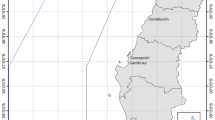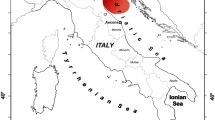Abstract
Predictive modeling of natural resources has long relied on mechanistic descriptions incorporating various population attributes and to a lesser extent environmental conditions. A radical departure from this tradition is proposed, advocating the data-driven analysis and forecasting of population cycles from historical records, and using the Atlantic white shrimp, Litopenaeus setiferus, as a case study. The time series data were collected in the Charleston Harbor (32°47′00″N, 79°56′00″W), South Carolina, USA, and from the database of the National Marine Fisheries Service (http://www.st.nmfs.gov/st1/commercial/index.html), for the period between January 1986 and December 2004. Correlations between shrimp population cycles and environmental hydrological parameters were established by phase space reconstruction, a technique central to most nonlinear time series analysis methods. Predictive models of future shrimp population levels were built using feed-forward artificial neural networks, a well-known machine learning technique. From several attempted strategies, predicting the state commercial harvest from the sampling of populations in the Charleston Harbor conducted by the South Carolina Department of Natural Resources proved to be optimal, with an accuracy of 92% for 1-month and 79% for 3-month ahead predictions, as measured by the nonparametric and nonlinear Spearman’s correlation coefficient. In addition, the shrimp population levels seem to be more sensitively to changes in surface water temperature than salinity, but the latter is also an important consideration. These models also suggest that catch-per-unit-effort data are important indicators of commercial harvest and, thus, provide an important linkage between monitoring programs and commercial returns, enabling accurate predictions of natural resources to be made in near real time and extended beyond the critical time frames within which resource managers operate.








Similar content being viewed by others
References
Almeida JS (2002) Predictive non-linear modeling of complex data by artificial neural networks. Curr Opin Biotech 13:72–76
Ball AO, Chapman RW (2003) Population genetic analysis of white shrimp, Litopenaeus setiferus, using microsatellite genetic markers. Mol Ecol 12:2319–2330
Baxter KN, Renfro WC (1967) Seasonal occurrence and size distribution of postlarval brown and white shrimp near Galveston, Texas, with notes on species identification. Fish Bull 66:149–158
Belcher CN, Jennings CA (2004) Evaluation of stock–recruitment curves for white shrimp in Georgia. North Am J Fish Manage 24:654–661
Beverton RJH, Holt SJ (1957) On the dynamics of exploited fish populations. Chapman & Hall, London
Calder CR, Eldridge PJ, Shealy MH Jr (1974) The shrimp fishery of the southeastern United States: a management planning profile. South Carolina Wildlife Marine Research Department. Technical report 5, September 1974
Farmer CH III, Whitaker JD, Chipley NL (1978) Pilot study to determine the overwintering patterns of white shrimp. South Carolina Wildlife and Marine Resources Department, Charleston
Garcia SP, Almeida JS (2005a) Nearest neighbor embedding with different time delays. Phys Rev E 71:037204
Garcia SP, Almeida JS (2005b) Multivariate phase space reconstruction by nearest neighbor embedding with different time delays. Phys Rev E 72:027205
Hornik K, Stinchcombe M, White H (1989) Multilayer feedforward networks are universal approximators. Neural Netw 2:359–366
Kantz H, Schreiber T (1997) Nonlinear time series analysis. Cambridge University Press, Cambridge
Kennel MB, Brown R, Abarbanel HDI (1992) Determining embedding dimension for phase-space reconstruction using a geometrical construction. Phys Rev A 45:3403–3411
Lam CF, Whitaker JD, Lee FS (1989) Model for white shrimp landings for the central coast of South Carolina. North Am J Fish Manage 9:12–22
Lindner MJ, Anderson WW (1956) Growth, migrations, spawning and size distribution of shrimp Penaeus setiferus. Fish Bull 56:553–645
Muncy RJ (1984) Species profiles: life histories and environmental requirements of coastal fishes and invertebrates (South Atlantic)—white shrimp. US Fish and Wildlife Service FWS/OBS–82/11.27
Myers RA, Worm B (2003) Rapid worldwide depletion of predatory fish communities. Nature 423:280–283
Pauly D, Christensen V, Walters C (2000) Ecopath, ecosim, and ecospace as tools for evaluating ecosystem impact fisheries. ICES J Mar Sci 57:697–706
Pérez-Farfante I (1969) Western Atlantic shrimps of the genus Penaeus. Fish Bull 67:461–591
Ricker WE (1954) Stock and recruitment. J Fish Res Board Can 11:559–623
Spearman C (1904) The proof and measurement of association between two things. Am J Psychol 15: 72–101
Takens F (1981) Dynamical systems and turbulence. Lect Notes Math 898:366–381
Voit EO (2000) Computational analysis of biochemical systems: a practical guide for biochemists and molecular biologists. Cambridge University Press, New York
Voit EO, Almeida JS (2004) Decoupling dynamical systems for pathway identification from metabolic profiles. Bioinformatics 20:1670–1681
Weigend AS, Bernardo BA, Rumelhart DE (1992) Predicting sunspots and exchange rates with connectionist networks. In: Casdagli M, Eubank S (eds) Nonlinear modeling and forecasting, Santa Fe institute studies in the sciences of complexity, vol 12. Addison Wesley Longman, USA, pp 395–432
Whitaker JD (1984) Effect of severe winter weather on white shrimp stocks in the Atlantic ocean off the southeastern United States. J Shellfish Res 4:103–104
Acknowledgments
Supported by grants SFRH/BD/1165/2000 and POCTI/1999/BSE/34794 from Fundação para a Ciência e a Tecnologia, Portugal; by the National Heart, Lung and Blood Institute (NIH) Proteomics Initiative contract N01–HV-28181 (D. Knapp, PI); and by NOAA/NMFS grants NA17FF2878 and NA03NMF4720362 (R. Chapman, PI). This is contribution number #606 to the Marine Resources Center, South Carolina Department of Natural Resources.
Author information
Authors and Affiliations
Corresponding author
Additional information
Communicated by J.P. Grassle.
Electronic supplementary material
Below is the link to the electronic supplementary material.
Rights and permissions
About this article
Cite this article
Garcia, S.P., DeLancey, L.B., Almeida, J.S. et al. Ecoforecasting in real time for commercial fisheries: the Atlantic white shrimp as a case study. Mar Biol 152, 15–24 (2007). https://doi.org/10.1007/s00227-007-0622-3
Received:
Accepted:
Published:
Issue Date:
DOI: https://doi.org/10.1007/s00227-007-0622-3




